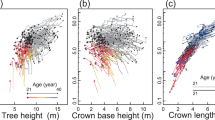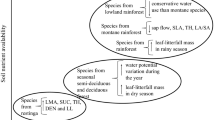Abstract
Leaf area index (LAI) is a key parameter controlling plant productivity and biogeochemical fluxes between vegetation and the atmosphere. Tropical forests are thought to have comparably high LAIs; however, precise data are scarce and environmental controls of leaf area in tropical forests are not understood. We studied LAI and stand leaf biomass by optical and leaf mass-related approaches in five tropical montane forests along an elevational transect (1,050–3,060 m a.s.l.) in South Ecuador, and conducted a meta-analysis of LAI and leaf biomass data from tropical montane forests around the globe. Study aims were (1) to assess the applicability of indirect and direct approaches of LAI determination in tropical montane forests, (2) to analyze elevation effects on leaf area, leaf mass, SLA, and leaf lifespan, and (3) to assess the possible consequences of leaf area change with elevation for montane forest productivity. Indirect optical methods of LAI determination appeared to be less reliable in the complex canopies than direct leaf mass-related approaches based on litter trapping and a thorough analysis of leaf lifespan. LAI decreased by 40–60% between 1,000 and 3,000 m in the Ecuador transect and also in the pan-tropical data set. This decrease indicates that canopy carbon gain, that is, carbon source strength, decreases with elevation in tropical montane forests. Average SLA decreased from 88 to 61 cm2 g−1 whereas leaf lifespan increased from 16 to 25 mo between 1,050 and 3,060 m in the Ecuador transect. In contrast, stand leaf biomass was much less influenced by elevation. We conclude that elevation has a large influence not only on the leaf traits of trees but also on the LAI of tropical montane forests with soil N (nitrogen) supply presumably being the main controlling factor.



Similar content being viewed by others
REFERENCES
Asner GP, Scurlock JMO, Hicke JA (2003) Global synthesis of leaf area index observations: implications for ecological and remote sensing studies. Global Ecol Biogeogr 12:191–205
Balslev H, Øllgaard B (2002) Mapa de vegetación del sur de Ecuador. In: Aguirre ZM, Madsen JE, Cotton E, Balslev H, Eds. Botánica Austroecuatoriana—Estudios sobre los recursos vegetales en las provincias de el Oro, Loja y Zamora-Chinchipe. Quito: Ediciones ABYA YALA, pp. 51–64
Barclay HJ, Trofymow JA (2000) Relationship of readings from the Li-Cor canopy analyser to total one-sided leaf area index and stand structure in immature Douglas-fir. Agric For Meteorol 132:121–6
Bréda NJJ (2003) Ground-based measurements of leaf area index: a review of methods, instruments and current controversies. J Exp Bot 54:2403–17
Brun R. 1976. Methodik und Ergebnisse zur Biomassenbestimmung eines Nebelwald-Ökosystems in den Venezolanischen Anden. Oslo: Proceedings Division I, 16th IUFRO World Congress. pp. 490–499
Chabot BF, Hicks DH (1982) The ecology of leaf life span. Annu Rev Ecol Syst 13:229–59
Chason J, Baldocchi D, Hutson M (1991) A comparison of direct and indirect methods for estimating forest leaf area. Agric For Meteorol 57:107–28
Chen JM, Black TA (1992) Defining leaf-area index for non-flat leaves. Plant Cell Environ 15:421–9
Chen JM, Rich PM, Gower ST, Norman JM, Plummer S (1997) Leaf area index of boreal forests: theory, techniques, and measurements. J Geophys Res 102:29429–43
Clark DA, Brown S, Kicklighter DW, Chambers JQ, Thomlinson JR, Ni J (2001) Measuring net primary production in forests: concepts and field methods. Ecol Appl 11:356–70
Coley PD, Bryant JP, Chapin FS (1985) Resource availability and plant anti-herbivore defense. Science 230:895–9
Comeau P, Gendron F, Letchford T (1998) A comparison of several methods for estimating light under a paper birch mixedwood stand. Can J For Res 28:1843–1850
Dufrêne E, Bréda N (1995) Estimation of deciduous forest leaf-area index using direct and indirect methods. Oecologia 104:156–62
Edwards PJ, Grubb PJ (1977) Studies of mineral cycling in a montane rain forest in New Guinea I. The distribution of organic matter in the vegetation and soil. J Ecol 65:934–69
Fassnacht KS, Gower ST, Norman JM, McMurtrie RE (1994) A comparison of optical and direct-methods for estimating foliage surface-area index in forests. Agric For Meteorol 71:183–207
Frangi JL, Lugo AE (1985) Ecosystems dynamics of a sub-tropical floodplain. Ecol Monogr 55:351–69
Gower ST, Kucharik CJ, Norman JM (1999) Direct and indirect estimation of leaf area index, fAPAR, and net primary production of terrestrial ecosystems. Remote Sens Environ 70:29–51
Grime JP, Cornelissen JHC, Thompson K, Hodgson JG (1996) Evidence of a causal connection between anti-herbivore defence and the decomposition rate of leaves. Oikos 77:489–94
Grubb PJ (1977) Control of forest growth and distribution on wet tropical mountains: with special reference to mineral nutrition. Annu Rev Ecol Syst 8:83–107
Herbert DA, Fownes JH (1999) Forest productivity and efficiency of resource use across a chronosequence of tropical montane soils. Ecosystems 2:242–54
Homeier J, Werner FW, Breckle SW, Richter M. 2007. Potential vegetation and floristic composition of Andean forests in South Ecuador, with a focus on the reserve San Francisco. In: Beck E, Bendix J, Kottke I, Makeschin F, Mosandl R, Eds. Gradients in a tropical mountain ecosystem in Ecuador. Ecological studies. Berlin: Springer (in press)
Inoue A, Yamamoto K, Mizoue N, Kawahara Y (2004) Effects of image quality, size and camera type on forest light environment estimates using digital hemispherical photography. Agric For Meteorol 126:89–97
Jonckheere I, Fleck S, Nackaerts K, Muys B, Coppin P, Weiss M, Baret F (2004) Review of methods for in situ leaf area index determination—Part I. Theories, sensors and hemispherical photography. Agric For Meteorol 121:19–35
Kikuzawa K (1989) Ecology and evolution of phenological pattern, leaf longevity and leaf habit. Evol Trends Plants 3:105–10
Kitayama K, Aiba S-I (2002) Ecosystem structure and productivity of tropical rain forests along altitudinal gradients with contrasting soil phosphorus pools on Mount Kinabalu, Borneo. J Ecol 90:37–51
Kitayama K, Aiba S-I, Takyu M, Majalap N, Wagai R (2004) Soil phosphorus fractionation and phosphorus-use efficiency of a Bornean tropical montane rain forest during soil aging with podzolization. Ecosystems 7:259–74
Köhler L (2002) Die Bedeutung der Epiphyten im ökosystemaren Wasser- und Nährstoffumsatz verschiedener Altersstadien eines Bergregenwaldes in Costa Rica. Ph.D. thesis, Göttingen, Germany, p. 131
Küßner R, Mosandl R (2000) Comparison of direct and indirect estimation of leaf area index in mature Norway spruce stands of eastern Germany. Can J For Res 30:440–7
Leuschner C, Moser G, Bertsch C, Röderstein M, Hertel D (2007) Large altitudinal increase in tree root/shoot ratio in tropical mountain forests of Ecuador. Basic Appl Ecol 8:219–30
Lowman MD (1992) Leaf growth dynamics and herbivory in five species of Australian rain-forest canopy trees. J Ecol 80:433–47
McWilliam ALC, Roberts JM, Cabral OMR, Leitao MVBR, Decosta ACL, Maitelli GT, Zamparoni CAGP (1993) Leaf-area index and aboveground biomass of terra-firme rain-forest and adjacent clearings in Amazonia. Funct Ecol 7:310–7
Medina E, Klinge H (1983) Productivity of tropical forests and tropical woodlands. Lange and others physiological plant ecology—encyclopedia of plant physiology. New York: Springer, vol 12d, pp. 281–303
Mussche S, Samson R, Nachtergale L, Schrijver AD, Lemeur R, Lust N (2001) A comparison of optical and direct methods for monitoring the seasonal dynamics of leaf area index in deciduous forests. Silva Fenn 35:373–84
Neumann HH, Den Hartog GD, Shaw RH (1989) Leaf-area measurements based on the hemispheric photographs and leaf-litter collection in a deciduous forest during autumn leaf-fall. Agric For Meteorol 45:325–45
Odum HT (1970) Summary: an emerging view of the ecological system at El Verde. In: Odum HT, Pidgeon RF, Eds. A tropical rain forest: a study of irradiation and ecology at El Verde, Puerto Rico. Washington DC: Division of Technical Information US Atomic Energy Commission, pp. I-191–I-289
Ovington JD, Olson JS (1970) Biomass and chemical content of El Verde lower montane rain forest plants. In: Odum HT, Pidgeon RF, Eds. A tropical rain forest: a study of irradiation an ecology at El Verde, Puerto Rico. Washington DC: Division of Technical Information US Atomic Energy Commission, pp. H-53–H-77
Poorter H, Van der Werf A (1998) Is inherent variation in RGR determined by LAR at low irradiance and by NAR at high irradiance? A review of herbaceous species. In: Lambers H, Poorter H, Van Vuuren MMI, Eds. Inherent variation in plant growth, physiological mechanisms and ecological consequences. Backhuys: Leiden, pp. 309–36
Raich JW, Russell AE, Vitousek PM (1997) Primary productivity and ecosystem development along an elevational gradient on Mauna Loa, Hawai’i. Ecology 78:707–21
Smith FW, Sampson AD, Long NJ (1991) Comparison of leaf area index estimates from tree allometrics and measured light interception. For Sci 37:1682–8
Takyu M, Aiba SI, Kitayama K (2003) Changes in biomass, productivity and decomposition along topographical gradients under different geological conditions in tropical lower montane forests on Mount Kinabalu, Borneo. Oecologia 134:397–404
Tanner EVJ (1980) Studies on the biomass and productivity in a series of montane rain forests in Jamaica. J Ecol 68:573–88
van Gardingen PR, Jackson GE, Hernandez-Daumas S, Russell G, Sharp L (1999) Leaf area index estimates obtained for clumped canopies using hemispherical photography. Agric For Meteorol 94:243–57
Wang HQ, Hall CAS, Scatena FN, Fetcher N, Wu W (2003) Modeling the spatial and temporal variability in climate and primary productivity across the Luquillo Mountains, Puerto Rico. For Ecol Manag 179:69–94
Weaver PL, Murphy PG (1990) Forest structure and productivity in Puerto Rico, Luquillo Mountains. Biotropica 22:69–82
Weiss M, Baret F, Smith GJ, Jonckheere I, Coppin P (2004) Review of methods for in situ leaf area index (LAI) determination Part II. Estimation of LAI, errors and sampling. Agric For Meteorol 121:37–53
Welles JM, Normann JM (1991) Instrument for indirect measurement of canopy architecture. Agric J 83:818–25
Whitford KR, Colquhoun IJ, Lang ARG, Harper BM (1995) Measuring leaf-area index in a sparse eucalypt forest—a comparison of estimates from direct measurement, hemispherical photography, sunlight transmittance and allometric regression. Agric For Meteorol 74:237–49
Wilcke W, Yasin S, Schmitt A, Valarezo C, Zech W. 2007. Soils along the altitudinal transect and in catchments. In: Beck E, Bendix J, Kottke I, Makeschin F, Mosandl R, Eds. Gradients in a tropical mountain ecosystem of Ecuador. Ecological studies. Berlin: Springer (in press)
Wilson PJ, Thompson K, Hodgson JG (1999) Specific leaf area and leaf dry matter content as alternative predictors of plant strategies. New Phytol 143:155–62
ACKNOWLEDGMENTS
We thank P. Emck and M. Richter (University of Erlangen) for supplying the rainfall data and S. Iost and F. Makeschin (University of Dresden) for providing the pH and soil C/N ratio data. We are also grateful to M. Unger (University of Göttingen) for data on SLA, leaf chemistry and radiation and to J. Homeier (University of Göttingen) for support in taking hemispherical photographs. Further, we want to thank M. Küppers (University of Hohenheim) who provided a second LAI-2000 instrument. We gratefully acknowledge the financial support offered by DFG (Germain Science Foundation) through a grant in the Research Unit 402 (Functionality in a Tropical Mountain Forest, subproject B8). We thank the Ministerio del Ambiente Loja-Zamora for granting a research permit, and the Fundación Científica San Francisco (Nature and Culture International) for the ongoing support at Estación Científica San Francisco.
Author information
Authors and Affiliations
Corresponding author
Rights and permissions
About this article
Cite this article
Moser, G., Hertel, D. & Leuschner, C. Altitudinal Change in LAI and Stand Leaf Biomass in Tropical Montane Forests: a Transect Study in Ecuador and a Pan-Tropical Meta-Analysis. Ecosystems 10, 924–935 (2007). https://doi.org/10.1007/s10021-007-9063-6
Received:
Accepted:
Published:
Issue Date:
DOI: https://doi.org/10.1007/s10021-007-9063-6




